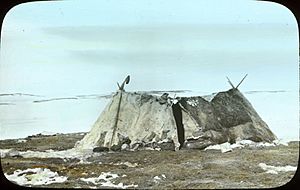Kangiryuarmiut facts for kids
The Kangiryuarmiut are a group of Inuvialuit people. They are closely connected to the Copper Inuit through their culture and history. Long ago, they lived on Victoria Island. Their homes were around Prince Albert Sound, Cape Baring, and the middle of Victoria Island. They often traveled with the seasons across their land. This included trips to Banks Island. They went as far south as Nelson Head and north to Mercy Bay. They collected materials from the old ship, HMS Investigator. Scientists have found many old sites from the Kangiryuarmiut. These sites are now in Aulavik National Park. Today, many Kangiryuarmiut still live on Victoria Island. They live in the community of Uluhaktok. This area is part of the Inuvialuit Settlement Region.
Language and Meaning
The Kangiryuarmiut speak Kangiryuarmiutun. This language is often seen as a sub-dialect of Inuvialuktun. However, it is more closely related to Inuinnaqtun. Inuvialuktun names for groups often describe places. These places are usually in the group's traditional land. The name Kangiryuarmiut means "the people of the large bay." This refers to Prince Albert Sound.
Traditional Life
The Kangiryuarmiut hunted bears for food. They were the only Copper Inuit group. They built iglooit (snow houses) on land.
Travel and Knowledge of the Land
The Kangiryuarmiut and the Kangiryuatjagmiut were the northernmost Copper Inuit. The Kangiryuatjagmiut lived near Minto Inlet. These groups traveled with the seasons. They moved across western Victoria Island and Banks Island. They also went to the mainland near Kugluktuk, Nunavut.
Before Europeans arrived, they traveled mostly by walking. They knew many place names along their routes. They also knew the stories connected to these places. This deep knowledge of the land was very important. It helped them understand their identity. It also helped them learn the Inuinnaqtun language.


